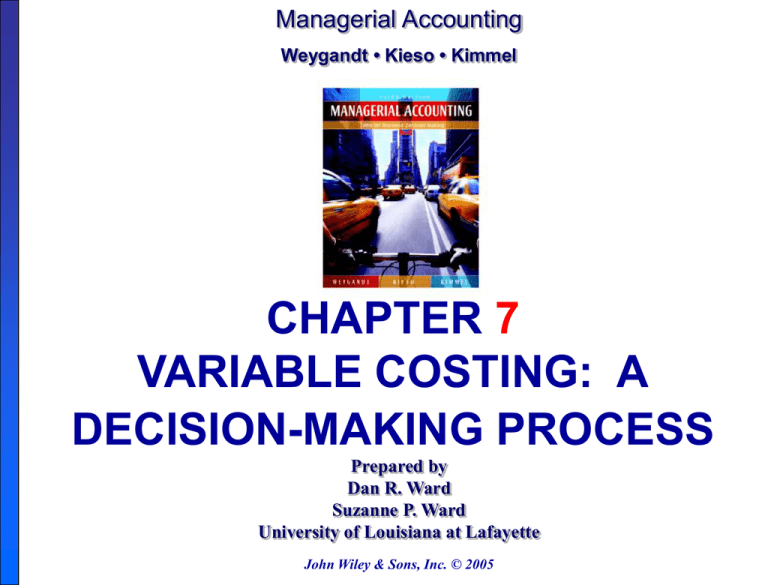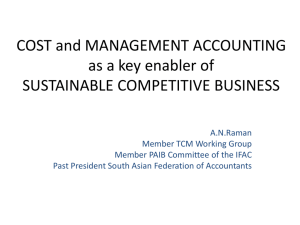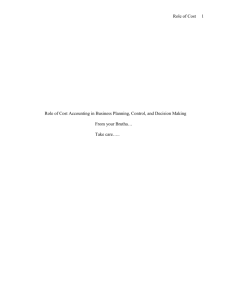
Managerial Accounting
Weygandt • Kieso • Kimmel
CHAPTER 7
VARIABLE COSTING: A
DECISION-MAKING PROCESS
Prepared by
Dan R. Ward
Suzanne P. Ward
University of Louisiana at Lafayette
John Wiley & Sons, Inc. © 2005
CHAPTER 7
VARIABLE COSTING:
A DECISION-MAKING PROCESS
Study Objectives
Explain the difference between absorption
costing and variable costing.
Discuss the effect that changes in
production level and sales level have on
net income measured under absorption
costing versus variable costing.
Study Objectives: Continued
Discuss the relative merits of absorption costing
versus variable costing for management decision
making.
Explain the term sales mix and its effect on
break-even sales.
Understand how
operating leverage
affects profitability.
ABSORPTION COSTING VERSUS
VARIABLE COSTING
Study Objective 1
Full or Absorption Costing
Assigns all variable and fixed manufacturing costs to the
product
Required for external reporting
Variable Costing
Assigns only variable manufacturing costs to the product
Direct material, direct labor, variable manufacturing
overhead
ABSORPTION COSTING VERSUS
VARIABLE COSTING
COMPARISON
Primary Difference
Under variable costing,
fixed manufacturing
overhead is an
expense in the current
period.
ABSORPTION COSTING VERSUS
VARIABLE COSTING
COMPARISON - Continued
Variable costing does not defer fixed manufacturing
overhead to the future - i.e., they are not inventoried
Net income under absorption costing compared to
net income under variable costing:
Higher when units produced exceed units sold
Lower when units produced are less than units sold
Equal when units produced and sold are the same:
• There is no ending inventory so fixed costs are not
deferred into the future
ABSORPTION COSTING VERSUS
VARIABLE COSTING
Example – Premium Products
Manufactures Fix-it, a sealant for car windows
Relevant data for the first month of production:
ABSORPTION COSTING VERSUS
VARIABLE COSTING
Example - Continued
Per unit manufacturing cost under each approach:
Manufacturing costs are $4 ($13 - $9) higher for absorption
costing because fixed manufacturing costs are product costs.
ABSORPTION COSTING VERSUS
VARIABLE COSTING
Absorption Costing Income Statement
ABSORPTION COSTING VERSUS
VARIABLE COSTING
Variable Costing Income Statement
ABSORPTION vs VARIABLE COSTING
Extended Example – Overbay Inc – Basic Data
Study Objective 2
Manufacturing cost per airplane drone $300,000 :
$240,000 variable and $60,000 fixed
Selling and administrative costs $130,000:
$50,000 variable and $80,000 fixed
ABSORPTION vs VARIABLE COSTING
Extended Example – Overbay Inc – Continued
Absorption Costing Income Statement - 2005
Net Income under Absorption Costing:
$870,000
ABSORPTION vs VARIABLE COSTING
Extended Example – Overbay Inc – Continued
Variable Costing Income Statement
Follows CVP format
Manufacturing costs include only the variable
manufacturing costs - $240,000 in 2005
Expense all fixed manufacturing cost - $600,000 in 2005
Reports same net income in 2005 as the Absorption
Costing Income Statement
ABSORPTION vs VARIABLE COSTING
Extended Example – Overbay Inc – Continued
Variable Costing Income Statement - 2005
Net Income under Variable Costing:
$870,000
ABSORPTION vs VARIABLE COSTING
Extended Example – Overbay Inc – Continued
Absorption Costing - 2006
10 drones produced; 8 drones sold; 2 drones in ending
inventory
Each unit in ending inventory includes $60,000 of fixed
manufacturing overhead
$120,000 ($60,000 X 2) of fixed manufacturing costs are
deferred until a future period
ABSORPTION vs VARIABLE COSTING
Extended Example – Overbay Inc – Continued
Absorption Costing Income Statement - 2006
Net Income under Absorption Costing:
$680,000
ABSORPTION vs VARIABLE COSTING
Extended Example – Overbay Inc – Continued
Variable Costing Income Statement - 2006
Net Income under Variable Costing:
$560,000
ABSORPTION vs VARIABLE COSTING
Extended Example – Overbay Inc – Continued
2006 Conclusions
When units produced (10) exceeds units sold (8),
net income under absorption costing ($680,000)
is higher than net income
under variable costing ($560,000).
Why?
Cost of ending inventory is higher under
absorption costing than under variable costing.
ABSORPTION vs VARIABLE COSTING
Extended Example – Overbay Inc – Continued
Absorption Costing - 2007
10 drones produced; 12 drones sold - 10 from current
year production and 2 from inventory
Fixed manufacturing overhead of $ 720,000 expensed
$120,000 from 2006 and included in beginning inventory
$600,000 incurred in 2007
When units produced (10) are less than units sold (12),
net income under absorption costing is less than net
income under variable costing by the amount of fixed
manufacturing costs included in beginning inventory.
ABSORPTION vs VARIABLE COSTING
Extended Example – Overbay Inc – Continued
Absorption Costing Income Statement - 2007
Net Income under Absorption Costing:
$1,060,000
ABSORPTION vs VARIABLE COSTING
Extended Example – Overbay Inc – Continued
Variable Costing Income Statement - 2007
Net Income under Variable Costing:
$1,180,000
ABSORPTION vs VARIABLE COSTING
Extended Example – Overbay Inc – Continued
Comparison of Net Income under the Two Approaches
ABSORPTION vs VARIABLE COSTING
Summary of Income Effects
DECISION-MAKING CONCERNS
Generally Accepted Accounting Principles (GAAP)
Must be followed for external reporting
Requires absorption costing for inventory
Does not differentiate between fixed and variable costs
Poor business decisions may result
Thus, variable costing used for internal decision
making
DECISION-MAKING CONCERNS
Example - Basic Data for Lighting Division
Decision: Produce 20,000 or 30,000 units?
DECISION-MAKING CONCERNS
Example – Continued
Comparative Absorption Costing Income Statements
At 20,000 units,
net income is
$85,000.
At 30,000 units,
net income is
$105,000 with
10,000 unit ending
inventory.
Difference in
income due to
$20,000 fixed costs
assigned to ending
inventory.
Based on these statements, should production be increased?
DECISION-MAKING CONCERNS
Example – Continued
Comparative Variable Costing Income Statements
At both levels,
net income is
$85,000.
Fixed costs
treated as a
period expense.
10,000 units
of ending
inventory
include only
variable costs.
Based on these statements, should production be increased?
ADVANTAGES OF VARIABLE
COSTING
Study Objective 3
Consistent with CVP and incremental analysis
Net income unaffected by changes in production
levels
Net income closely tied to changes in sales levels –
not production levels
Easier to identify fixed and variable costs and
their effect on company
SERVICE COMPANY PERSPECTIVE
Distinction between fixed and
variable costs very relevant
Shipping companies rely heavily
on variable costing for pricing
decisions
When operating below full
capacity, absorption costing results
in a high charge per shipment
Resulting in price too high
compared to competitors
Creates further decline in
operations
Let’s Review
Fixed manufacturing overhead costs are
recognized as:
a. Period costs under absorption costing
b. Product costs under absorption costs
c. Product costs under variable costing
d. Part of ending inventory costs under both
absorption and variable costing
Let’s Review
Fixed manufacturing overhead costs are
recognized as:
a. Period costs under absorption costing
b. Product costs under absorption costs
c. Product costs under variable costing
d. Part of ending inventory costs under both
absorption and variable costing
SALES MIX
Study Objective 4
Companies often sell more than
one product
Critical decision:
what mix of products to sell
Relative percentage in which each
product is sold when more than
one product is sold
Important because different
products have substantially
different contribution margins
SALES MIX
Break-Even Sales In Units
Steps for a mix of two or more products:
Compute the weighted-average unit contribution
margin of all the products:
Product 1 Unit Contribution Margin X Percentage of Sales
+ Product 2 Unit Contribution Margin X Percentage of Sales
= Weighted Average Unit Contribution Margin
Compute the break-even point in units:
Fixed Costs )
even
Weighted Average
Unit Contribution
Margin
=
Break-
Point
in Units
SALES MIX
Break-Even Sales In Units
Example – Vargo Video Basic Data
Sells both DVD players and TVs
Fixed costs of $200,000
SALES MIX - Break-Even Sales In Units
Example – Vargo Video Continued
Determine weighted-average unit contribution margin for the
sales mix of 75 percent DVDs and 25 percent TVs:
Determine the break-even point in units:
SALES MIX - Break-Even Sales In Units
Example – Vargo Video (Continued)
Verify the number of DVDs and TVs to be sold to break even
with a sales mix of 75 % DVDs and 25 % TVs and with fixed
costs of $200,000:
SALES MIX
Break-Even Sales In Units
At any level of units sold,
net income will be greater
if more high contribution margin units
are sold
than low contribution margin units.
SALES MIX
Break-Even Sales In Dollars
Steps for a mix of many products in two or more
product lines or divisions:
Compute the weighted-average unit contribution
margin ratio of all product lines or divisions:
Division 1 Contribution Margin Ratio X Percentage of Sales
+ Division 2 Contribution Margin Ratio X Percentage of Sales
= Weighted Average Contribution Margin Ratio
Compute the break-even point in dollars:
Fixed Costs
even
)
Weighted Average
Contribution
Margin Ratio
=
Break-
Point
in Dollars
SALES MIX
Break-Even Sales In Dollars
Example – Kale Garden Supply Co. Basic Data
Total fixed costs $300,000
Two Product Divisions:
Indoor Plants:
Sales Mix Ratio
Contribution Margin Ratio
20%
40%
Outdoor Plants:
Sales Mix Ratio
Contribution Margin Ratio
80%
30%
SALES MIX - Break-Even Sales In Dollars
Example – Kale Garden Supply (Continued)
Determine weighted-average contribution margin ratio for all
divisions:
Determine the break-even point in dollars:
SALES MIX - Break-Even Sales In Dollars
Example – Kale Garden Supply (Continued)
Using Kale’s sales mix of 20 percent and 80 percent,
break-even sales from each division:
Indoor Plant Division:
$187,500
(.20 X $937,500)
Outdoor Plant Division:
$750,000
(.80 X $937,500)
SALES MIX - Break-Even Sales In Dollars
Example – Kale Garden Supply (Continued)
Break-even point affected by a shift in sales from
one division to another
Shift sales to the Indoor Plant Division:
Division’s higher contribution margin ratio increases
weighted average contribution margin ratio
Results in a lower break-even point in sales dollars
Shift sales to the Outdoor Plant Division:
Opposite effect occurs due to Division’s lower
contribution margin ratio
SALES MIX
Understanding and managing
sales mix is
critical to company success
COST STRUCTURE AND
OPERATING LEVERAGE
Study Objective 5
Cost Structure
Relative proportion
of fixed versus
variable costs for a
company
Can have a
significant impact
on profits
COST STRUCTURE AND
OPERATING LEVERAGE
Operating Leverage
Extent to which a company’s net income
reacts to a given change in sales
Higher fixed cost structure increases
sensitivity to changes in sales; thus, higher
operating leverage
Profits increase rapidly when sales increase
and plunge drastically when sales decrease
When used carefully, can add to company
profitability
COST STRUCTURE AND
OPERATING LEVERAGE
Example – Makers of Croquet Mallets
Old English Mallet Company - Labor-intensive
manufacturing approach
New Wave Mallet Company - Completely
automated system
Same sales and same net income
Managed differently due to different cost structures
COST STRUCTURE AND
OPERATING LEVERAGE
Effect on Contribution Margin Ratio
Example – Makers of Croquet Mallets (Continued)
Higher cost structure for New Wave
More sensitive to changes in sales
Higher operating leverage
Net income increases 60¢ for each additional sales dollar
Net income decreases 60¢ for each lost sales dollar
COST STRUCTURE AND
OPERATING LEVERAGE
Degree of Operating Leverage
Measures earnings volatility
Example – Makers of Croquet Mallets (Continued)
Higher operating leverage for New Wave
Net income changes 4 times (6 ÷ 1.5) as much as Old
English with an equal change in sales
Exposed to greater earnings volatility risk
COST STRUCTURE AND
OPERATING LEVERAGE
Effect on Break-Even Point
Example – Makers of Croquet Mallets (Continued)
Higher break-even point for New Wave
Needs $150,000 more in sales than Old English to break
even
Riskier than Old English
Cannot survive for very long unless it breaks even
COST STRUCTURE AND
OPERATING LEVERAGE
Effect on Margin of Safety Ratio
Example – Makers of Croquet Mallets (Continued)
Old English could sustain a 67 percent decline in sales
before operating at a loss
New Wave could only have a 17 percent decline in
sales prior to being in “the red”
Thus, New Wave is riskier than Old English
Summary of Study Objectives
Explain the difference between absorption costing
and variable costing
Absorption costing:
Fixed manufacturing costs are product costs
Variable costing:
Fixed manufacturing costs are period costs
Summary of Study Objectives
Explain the effect that changes in production level have
on net income measured under absorption costing versus
variable costing
If production volume exceeds sales volume, net income under
absorption costing will be higher by the amount of fixed
manufacturing costs in ending inventory
If production volume is less than sales volume, net income under
absorption costing will be less by the amount of fixed
manufacturing costs in the units sold but not manufactured
during the period
Summary of Study Objectives
Discuss the relative merits of absorption costing versus
variable costing for management decision making.
Variable costing is consistent with CVP analysis and incremental
analysis
Net income under variable costing is unaffected by changes in
production levels
Variable costing allows easier identification of fixed costs and the
evaluation of their impact on profitability
Explain the term sales mix and its effect on break-even
sales.
Sales mix is the relative proportion in which each product is sold
In a multi-product company, break-even sales in dollars is
calculated using the weighted-average contribution margin ratio
Summary of Study Objectives
Understand how operating leverage
affects profitability.
The degree to which a company’s net income
reacts to a change in sales
Determined by a company’s relative use of
fixed versus variable costs
Companies with high fixed costs relative to
variable costs have high operating leverage
and vice versa
High operating leverage results in a sharp
increase (decrease) in net income with an
increase (decrease) in sales
The degree of operating leverage can be
measured by dividing contribution margin
by net income
Let’s Review
Sales mix is:
a. Important to sales managers but not to
accountants
b. Easier to analyze on absorption costing income
statements
c. A measure of the relative percentage of a
company’s variable costs to its fixed costs
d. A measure of the relative percentage in which a
company’s products are sold
Let’s Review
Sales mix is:
a. Important to sales managers but not to
accountants
b. Easier to analyze on absorption costing income
statements
c. A measure of the relative percentage of a
company’s variable costs to its fixed costs
d. A measure of the relative percentage in which a
company’s products are sold
COPYRIGHT
Copyright © 2005 John Wiley & Sons, Inc. All rights reserved. Reproduction or
translation of this work beyond that permitted in Section 117 of the 1976 United
States Copyright Act without the express written consent of the copyright owner is
unlawful. Request for further information should be addressed to the Permissions
Department, John Wiley & Sons, Inc. The purchaser may make back-up copies for
his/her own use only and not for distribution or resale. The Publisher assumes no
responsibility for errors, omissions, or damages, caused by the use of these
programs or from the use of the information contained herein.







